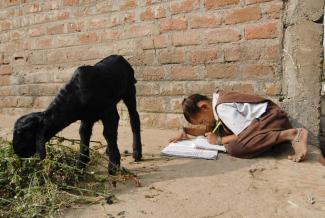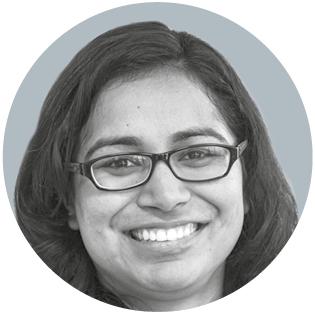Social inclusion
The parents’ burden

Pinky works as a maid in about seven households in Lucknow, the capital of one of the most populous states in India. Her husband’s income is erratic, but nonetheless, she sends her 10-year-old girl to a low-cost private school in the city. She wants her child to learn English and not to depend on menial jobs in future.
The girl is the first person in the family to attend a school. She represents a transformation that is changing India. Both in urban and rural settings, young Indians are surpassing their parents’ levels of education. In the 1990s, a rule of thumb said that about half of India’s school-age population was not going to school.
Today, about 70 % of those aged 18 still attend school. In 2001, the rate was a dismal 25 %. According to the Annual Status of Education Report (ASER) 2018, the percentage of unenrolled girls has dropped. For the age group 11 to 14, it has fallen to a mere 4.1 % from 10.3 % in 2006. Even in rural areas, girls have caught up with boys to a very large extent. At the age of 14, now 94 % of girls and 95 % of boys are enrolled in school.
This is good news. Nonetheless, serious problems persist. Far too many students who pass elementary school are still barely literate. For recent years, ASER data consistently shows abysmal learning outcomes.
Today, some 250 million young Indians are going to school. That is about 20 % of the nation’s population and more than three times the population of Germany. The future of the economy depends on this generation getting a good education, and obviously, their personal futures too. Nonetheless, the burden of ensuring that they really are taught properly lies heavily on the parents. And parents are choosing private education alternatives as student enrolment in government schools is declining.
There has always been a bias for private education over public education in India. Wealthy parents have a long history of sending their offspring to private institutions. A more recent trend is the emergence of low-cost private schools. Their enrolment numbers have increased from 44 million (2010/11) to 61 million (2016/17), while those in government schools fell from 126 million to 108 million in 21 states for which data was available. School fees can be as low as the equivalent of $ 10 per month.
These low-cost schools are profit-driven and distinct from institutions that some non-governmental schools run in slums and villages. Charitable schools deliver valuable services to some marginalised communities, but there are far too few of them to educate the masses of children from poor families. In contrast to the past century, however, most of those families are no longer so poor that they barely survive, so they can afford to invest small sums in the next generation’s future. Moreover, the average number of children of low-income women have has dropped to 3.2. That also makes it easier to spend money on tuition.
Geeta G. Kingdon, a professor of University College London, has written a book about private schools in India. She suspects that not only enrolment in low-cost private schools has increased, but that their number has grown too. The official statistics are not reliable because many schools are not officially registered.
One reason parents find them attractive, Kingdon points out, is the use of English as the language of instruction. For several reasons, it is important to speak good English in India. The tongue of the former colonial power is still widely used in government, law, business, academia et cetera, and the internet is reinforcing its relevance. It also matters that especially south Indian people tend to resent the use of Hindi, which is officially the national language, but linguistically very different from south Indian languages.
State-run primary and secondary schools tend to be dilapidated and dingy, the professor adds. Public schools typically lack basic things like electric power and proper toilets. They do not have enough teachers, and staff tends to be unmotivated. On the other hand, low-cost private schools generally have better infrastructure and provide a better environment for learning. It is a problem, however, that they are neither properly regulated nor monitored.
In the Indian political discourse, leaving things to market forces is highly controversial. Advocates of private schools bemoan what they consider a hostile environment for education entrepreneurship. They argue that low-cost private schools are an affordable and better alternative to public schools and only require a fraction of the government funding. Others, however, want governments at both the central and state levels to finally do their job. They point out that the liberalisation of primary and secondary education means that the poorest will be left behind, and equal opportunities will become even more elusive.
The central government is using the principle of competitive federalism for ensuring better educational facilities and opportunities. The idea is to put “pressure on policymakers across states to perform better on predefined goals and metrics”, says Amitabh Kant, the leader of the National Institution for Transforming India (NITI Aayog), a government body designed to drive economic development. NITI Aayog has developed the School Education Quality Index (SEQI) to assess performance at the level of the individual states.
The current central government, moreover, has made various efforts to streamline a range of education-related programmes. However, to judge based on its initial intentions, it is behind schedule. After taking office five years ago, Prime Minister Narendra Modi’s team planned to implement a New Education Policy (NEP). Two parliamentary committees and 115,000 consultations later, it is still work in progress. With general elections around the corner, it is unlikely that NEP will see the light of day.
In the eyes of non-governmental activists, India definitely lacks a coherent education policy. They see shortcomings with regard to quality, innovation and outcomes. Moreover, schools do not teach the skills that are in demand in the labour market. “A broader education policy is a need,” says Parth J. Shah of the Centre for Civil Society, a liberal think tank. A core demand of its School Choice Campaign is the improvement of low-cost private schools.
Roli Mahajan is a freelance journalist.
roli.mahajan@gmail.com













